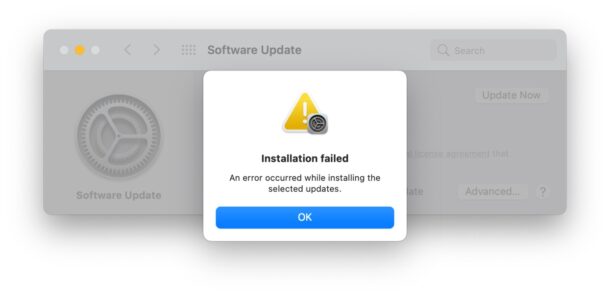If you own a Mac, you may have encountered a frustrating situation where you try to download a file or update an app, only to be met with a failed download error message. This can be particularly troublesome when you need to update important software or download essential files. In this article, we will explore the possible causes of failed download errors on Mac and provide you with some troubleshooting steps to resolve the issue.
Insufficient Disk Space:
One common reason for failed downloads on Mac is insufficient disk space. If your Mac’s storage is nearing its capacity, it may not have enough room to accommodate the new file or app you are trying to download. To check your disk space, click on the Apple menu and select “About This Mac.” Then, go to the “Storage” tab and assess the available space. If the space is limited, try deleting unnecessary files or moving them to an external hard drive to free up space.
File/App Corruption or Damage:
Another possible cause of failed downloads is file or app corruption or damage. If the file you are trying to download is corrupted or damaged, your Mac may not be able to complete the download. Similarly, if the app you are trying to update is corrupted, the download may fail. In such cases, you can try downloading the file or app from an alternative source, or contact the developer for further assistance.
Incorrect Security Settings:
Sometimes, your Mac’s security settings can prevent downloads from completing successfully. If the file you are trying to download is flagged as potentially harmful or if your Mac’s security settings are too restrictive, the download may fail. To resolve this issue, go to “System Preferences” and click on “Security & Privacy.” In the “General” tab, ensure that the option “Allow apps downloaded from” is set to “App Store and identified developers.” If necessary, temporarily disable any antivirus software or firewall settings that could be interfering with the download.
Insufficient RAM:
Insufficient RAM (Random Access Memory) can also contribute to failed downloads on Mac. If your Mac does not have enough available RAM to handle the downloading process, it may result in errors. To check your RAM usage, open “Activity Monitor” (found in the Utilities folder within the Applications folder). In the “Memory” tab, you can assess your current RAM usage. If it is consistently high or close to maximum, consider upgrading your Mac’s RAM to improve its performance.
Other Troubleshooting Steps:
If you have tried the above solutions and are still experiencing failed download errors on your Mac, here are a few additional troubleshooting steps you can take:
1. Restart your Mac: Sometimes, a simple restart can resolve temporary issues and clear out any lingering processes that may be interfering with the download.
2. Manually download the update: If you are trying to update a specific app or software, visit the developer’s website and download the update manually. This bypasses any potential issues with the automatic update process.
3. Boot in Safe Mode: Starting your Mac in Safe Mode can help identify and resolve issues that may be causing the failed downloads. To boot in Safe Mode, restart your Mac and hold down the Shift key until the Apple logo appears.
4. Repair your hard drive: Use Disk Utility (found in the Utilities folder) to repair any potential disk errors. Open Disk Utility, select your hard drive, and click on “First Aid” to run the disk repair process.:
Failed download errors can be frustrating, but with the right troubleshooting steps, you can resolve the issue on your Mac. Ensure that you have enough disk space, check for file or app corruption, review your security settings, and assess your RAM usage. If these steps don’t resolve the issue, try restarting your Mac, manually downloading the update, booting in Safe Mode, or repairing your hard drive. By following these steps, you can overcome failed download errors and keep your Mac running smoothly.

Why Does Your Mac Keep Saying Failed to Download?
There can be several reasons why your Mac keeps saying “failed to download.” Here are some possible explanations:
1. Insufficient disk space: If your Mac’s storage is full, there may not be enough space to download the file. Check your available disk space by clicking on the Apple menu, selecting “About This Mac,” and then clicking on the “Storage” tab. If your storage is nearly full, consider freeing up space by deleting unnecessary files or transferring them to an external storage device.
2. Corrupted or damaged file/app: The file or app you are trying to download may be corrupted or damaged. This can happen if the file was not properly uploaded or if there were errors during the download process. Try downloading the file again from a reliable source or contact the app developer for assistance.
3. Incorrect security settings: Your Mac’s security settings may be preventing the download. Check your Mac’s security preferences by going to the Apple menu, selecting “System Preferences,” and then clicking on “Security & Privacy.” Make sure that the settings allow downloads from trusted sources and that any firewall or antivirus software is not blocking the download.
4. Network connection issues: A weak or unstable internet connection can cause download failures. Ensure that you have a stable internet connection and try downloading the file again. If you are using Wi-Fi, try connecting your Mac directly to the router with an Ethernet cable for a more reliable connection.
5. Outdated software: If your Mac’s operating system or web browser is outdated, it may struggle to download certain files. Check for software updates by going to the Apple menu, selecting “System Preferences,” and then clicking on “Software Update.” Install any available updates and try downloading the file again.
If your Mac keeps saying “failed to download,” it could be due to insufficient disk space, a corrupted file or app, incorrect security settings, network connection issues, or outdated software. By addressing these potential causes, you may be able to resolve the issue and successfully download the desired file or app.
Why Does Your Mac Update Keep Failing?
There can be several reasons why your Mac update keeps failing. Let’s explore some possible causes:
1. Insufficient RAM: Mac updates require a certain amount of memory to download and install. If your Mac has low RAM, it may struggle to complete the update process. Consider upgrading your RAM if it falls below the recommended specifications for the update.
2. Limited storage space: Updates often require a significant amount of disk space to download and install. If your Mac’s storage is nearly full, the update may fail. Free up some space by deleting unnecessary files or moving them to an external drive.
3. Internet connection issues: A stable internet connection is essential for downloading updates. If your Wi-Fi or Ethernet connection is weak or intermittent, the update may fail. Ensure that you have a reliable internet connection before attempting the update.
4. Software conflicts: Sometimes, third-party software or incompatible applications can interfere with the update process. Try closing all running applications and disabling any antivirus or firewall software temporarily. This may help resolve any conflicts and allow the update to proceed.
5. Outdated software: If you have outdated software or firmware on your Mac, it may prevent the update from installing correctly. Check for any available software updates in the App Store or the System Preferences’ Software Update section. Install these updates before attempting the Mac update.
6. Corrupted system files: Over time, system files on your Mac can become corrupted, leading to update failures. To fix this, you can try booting your Mac in safe mode by holding the Shift key while restarting. Safe mode performs a basic check of your system files and may resolve any issues.
7. Hard drive errors: If there are errors on your Mac’s hard drive, it can hinder the update process. Open Disk Utility (found in the Utilities folder within the Applications folder) and run a First Aid scan on your startup disk. This will check for and repair any disk errors that may be causing the update to fail.
If none of these solutions work, you may need to contact Apple Support for further assistance. They can provide more specific guidance based on your Mac’s model and the specific update you’re trying to install.
Conclusion
Encountering a failed download error on your Mac can be frustrating, but there are several steps you can take to resolve the issue. First, ensure that you have enough available disk space on your Mac to accommodate the file or application you are trying to download. If your storage is full, consider deleting unnecessary files or transferring them to an external drive to free up space.
If you have confirmed sufficient storage space, it is possible that the file or app itself is corrupted or damaged. In such cases, try downloading a different version of the file or contact the developer for assistance.
Additionally, incorrect security settings on your Mac can prevent downloads from being completed successfully. Review your security preferences and adjust them accordingly to allow for the download.
If you have followed all the above steps and are still experiencing issues, try restarting your computer. Sometimes, a simple restart can resolve temporary glitches or conflicts that may be interfering with the download process.
If the problem persists, you can attempt to download the update manually. Visit the official website or trusted sources to find the specific update you need, and follow the instructions provided to download and install it on your Mac.
Lastly, if none of the above solutions work, consider booting your Mac in safe mode. Safe mode starts up your Mac with minimal system extensions and only necessary software, which can help identify and resolve any software conflicts that may be causing the failed download error.
If none of these steps resolve the issue, you can try repairing your hard drive using Disk Utility. Open Disk Utility, select your hard drive, and choose the option to repair the disk. This process can fix any underlying disk errors that may be causing the download problem.
Encountering a failed download error on your Mac can be caused by insufficient disk space, corrupted files, incorrect security settings, or software conflicts. By following the steps outlined above, you can troubleshoot and resolve the issue, allowing you to successfully download updates and files on your Mac.








